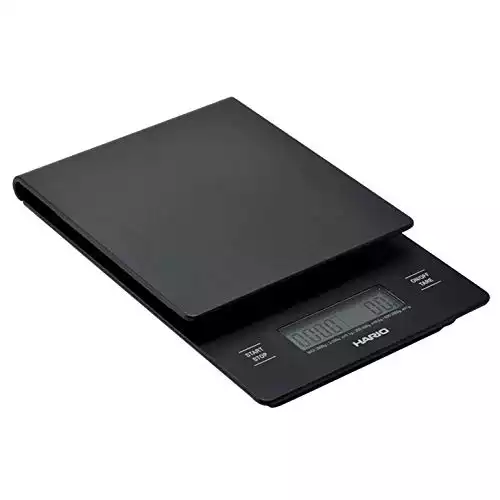Coffee To Water Ratio Calculator: Tips & Tricks
You brewed your cup of coffee, and you’re shocked by how sour it tastes. Or you figure you bought the wrong coffee; why does this taste like wood? And what happened to the sweetness the roaster bragged about?
The culprit might not be the coffee you bought or a misleading roaster’s promise. The guilty party might be the ratio.
The coffee to water ratio is a little understood, often abused, and nearly always misused factor when making coffee.
I’m a coffee professional with 10 years of experience working with baristas, farmers and roasters and helping them perfect their craft. So keep reading to get my best tips on how to perfect your brew.
Want a quick answer to find out the best ratio for your brew methods? This fantastic tool below takes the guesswork out of brew ratios to give you the best coffee.
Why You Need the Right Coffee Ratio
In training sessions I give for people entering the coffee industry, ratios are always on the agenda. They’re one of the first things people want to know about, and they’re perhaps one of the last aspects they truly understand.
The reason why we care about ratios when we brew coffee is simple. We want a fantastic tasting coffee. After all, if you feel fine drinking coffee that tastes bad, you wouldn’t worry about methods, scales, or finding the perfect coffee beans.
In your search for memorable tastes, you’ve no doubt come across a lot of bad eggs, so to speak. Those coffees that are intensely bitter. That aftertaste of sour grapes. Or the cup that simply didn’t taste like anything at all. They are all results of mistakes, and most often mistakes when brewing.
Brewing coffee involves science, and it’s a very tasty science project. We’ll talk about the science part in a bit. But for now, know that the wrong amount of coffee will never get you the right tastes.
Simply put, good ratios lead to good tastes in the cup regardless if you’re making cold brew coffee or a simple drip-brew.
Think of the last time you had a cup of tea. Did it matter how much sugar you added to that tea? If you add two tablespoons of sugar to a small cup of tea, how would that tea taste?
Without even thinking about it, you figure out the ratios to decide on the right amount of sweetener. You calculate how much water is in that teacup, how sweet you like your tea, and you add the teaspoons accordingly. With this sugar comparison we can see that ratios are important.
Now that you see the importance of the right coffee ratio, let’s talk about a necessary tool for coffee brewing.
Get A Scale To Measure Ground Coffee Grounds
One of the most important tools is a scale. Why do you need a scale?
Remember that time you had a coffee that didn’t taste like anything? If that’s happened to you, perhaps you eyeballed the ratio. Maybe you used more or less two tablespoons of coffee grinds for what might have been 8 ounces of water (or maybe 12 ounces).
Then you tasted the coffee and found you had some colored water. You realized that eyeballing the amounts wasn’t the way to go. You needed to have specific measurements.
When you measure coffee and water using tablespoons, cups, or by using that little line on your coffee pot, you measure coffee by volume.
The problem when you measure coffee by volume is that you can’t consider several factors.
To brew good coffee, you need precision. How precise can you get when you use a tablespoon to measure coffee? Are you accurate to the gram? No. And different cups, even measuring cups, actually have different volumes.
How can you eliminate that guesswork? By using a scale. A good scale is accurate for measuring coffee.
Also, when you measure out whole bean coffee by volume, the amount you get is different than when you weigh them.
There’s no mystery there.
Whole coffee beans take up more space in a measuring cup or tablespoon because there’s a lot of air between the beans.
A tablespoon of whole beans weighs a lot less than a tablespoon of ground coffee. Eliminate the problem by weighing the beans.
Why Density Matters
Now that you’re convinced you need to weigh your coffee beans, here’s another twist to the story. Density.
The denser the coffee beans are, the more compact they are. More compact coffee beans mean you’ll get more coffee per volume.
A tablespoon of dense coffee beans will have more than a tablespoon of coffee beans that are not as dense.
Does that matter? Yes, it can be the difference between a good brew and a bitter brew.
The density of coffee beans can vary a lot. What factors make coffee beans denser?
Variety – some varieties produce denser beans. For example, expect Bourbon coffee beans to be denser.
Altitude – coffees grown at higher altitudes (1200-1370 meters above sea level) are denser because the cherries ripen slower. That longer growing time makes for denser beans.
Humidity – Coffee beans with more humidity will have less density.
Roast – As coffee beans are roasted longer, the cell structure breaks down. For that reason, a dark roast will generally have less density than a lighter roast.
While green coffee experts can calculate the approximate density of whole coffee beans just by looking at them, that takes a lot of training. For most people, you need to rely on a scale.
Now let’s tackle the numbers and give you the best brew ratio.
What’s The Best Coffee to Water Ratio?
You’re convinced that you need to use a coffee to water ratio and that weighing your beans and water is the only way to get consistent, delicious results. Now it’s time to give you the optimal coffee to water ratio.
Coffee to water ratios varies between 1:10 to 1:18. Your ideal ratio is going to fall between those two numbers.
In professional coffee cupping sessions, we use standard ratios to brew the coffee. Established by the Specialty Coffee Association, that ratio is 8.25 grams of whole bean coffee to 5.07 ounces of water.
When you brew coffee at home, though, you can experiment with different ratios. The main way to determine your ratio is to consider what you expect in your cup.
Do you want a strong brew with an intense body? Do you prefer a tea-like brew with subtle nuances? Do you prize sweetness over everything else?
Will you add something to your brew?
If you add dairy products (or non-dairy products) to your cup, you may want a stronger brew with more body. If you don’t plan to add sugar, you might want to brew for additional sweetness. All those factors determine the ratio you’ll choose.
How Brewing Methods Change The Ratio
Now I have to throw in an additional factor. This is because brew ratios also depend on the brewing method.
The barista at your coffee shop may say they use the same ratio for any brew method and coffee. But they may do this more for ease of brewing in a busy coffee shop and less in the interest of getting the best results.
For you at home, you can give yourself the luxury of determining the best ratio for the methods you have in your kitchen. This doesn’t have to be complicated; most people only have a few methods at home.
I have about 10 methods on my home coffee station, so I have to keep in mind many different ratios and pouring techniques. But it’s because I’m a coffee professional, and it’s not what normal human beings do.
In your case, scan this article to find the methods you have at home and use the suggested ratio as a starting point to brew coffee. Of course, you can always adjust the ratio and add more coffee or water the next time.
If you need a quick answer (or if you’re severely allergic to math), use this water ratio calculator.
Coffee To Water Ratio Calculator
Drip Coffee Ratio
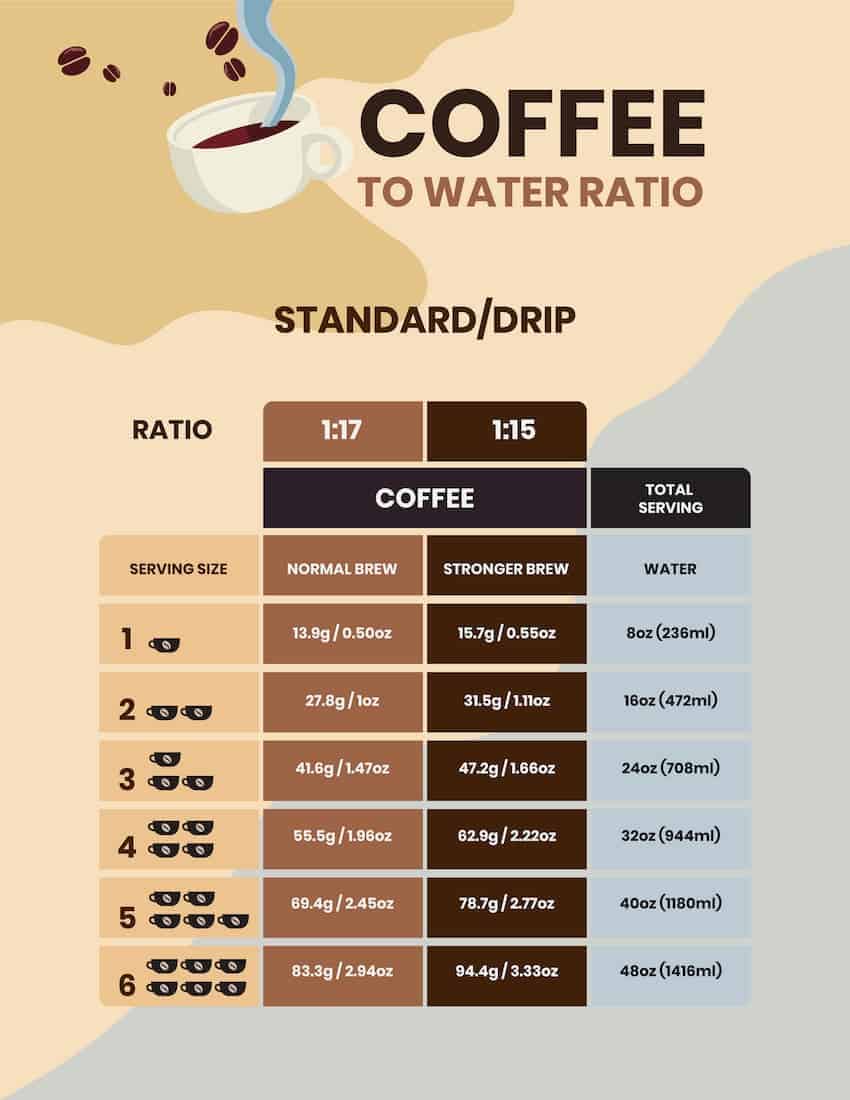
When you make coffee in drip coffee makers, you generally can’t control pouring techniques or bloom times. The good news is that you can control the ratio with filter coffee.
You can use a coffee to water ratio of 1:15 to 1:17. Use a 1:15 ratio if you want stronger coffee from your coffee machine.
This ratio chart can help you with the actual grams or ounces you need for anywhere from 1 to 6 cups of water. For example, for one 8-ounce cup of normal coffee, you can start with 13.9 grams of coffee. You can increase that by about 2 grams for a stronger brew.
French Press Coffee Ratio
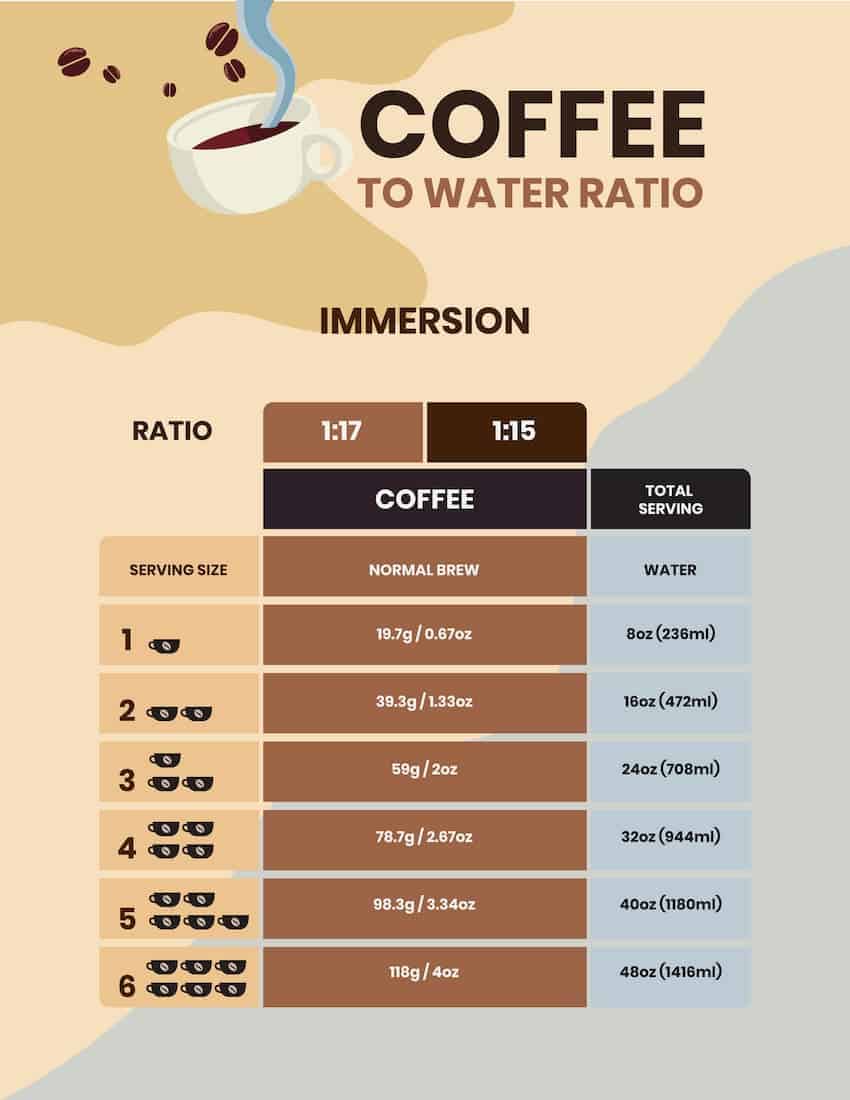
The French Press method gives you a strong coffee with intense body. And it does it without the complexities of mastering pouring techniques.
You simply place the coffee in the carafe, add water, and wait 3-4 minutes for the brew time. When the brew time is up, press the plunger and pour off the coffee.
With a French Press, you can start with a brew ratio of 1:12, although you can vary that depending on your taste and the brewing time. For an 8-ounce cup, start with 19.7 grams of coffee.
The French Press method is an immersion method, so keep that in mind when using the ratio calculator.
Pour Over Coffee Ratio
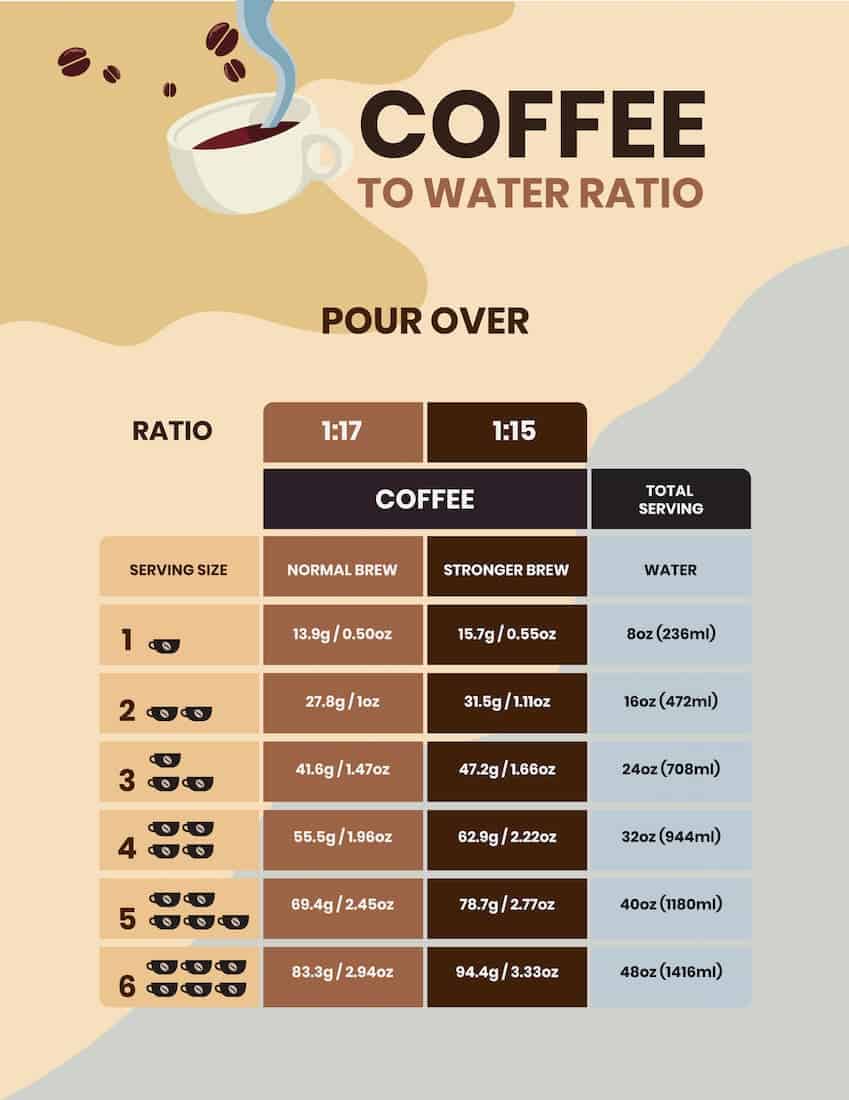
Pour-over coffee methods create the best of two worlds: drip and immersion methods.
Generally, the coffee is immersed in water for a brief period before it drips through a paper or metal filter.
Making coffee in a pour-over means you can experiment with wildly different ratios and still get good results.
How much coffee should you use?
A good starting point for pour-overs is a 1:15 coffee to water ratio. You can go as far as 1:17 if you want a more subtle cup, or reduce the water amount to 1:13 if you’re looking for a cup with a punch. If you want a clean cup with plenty of clarity of flavors, use a higher water to coffee ratio.
For instance, in tastings, I will often brew a V60 pour-over for sweetness and clarity. I don’t want to go too high with the ratio, so I opt for a 1:15 ratio. For an 8-ounce cup, that would be 15.7 grams of coffee. You can lighten the flavors by reducing the amount to 13.9 grams of coffee per cup.
This chart will make it easier to figure out the specific grams or ounces for each cup of water if you want to use a 1:15 or a 1:17 ratio.
Espresso Ratios
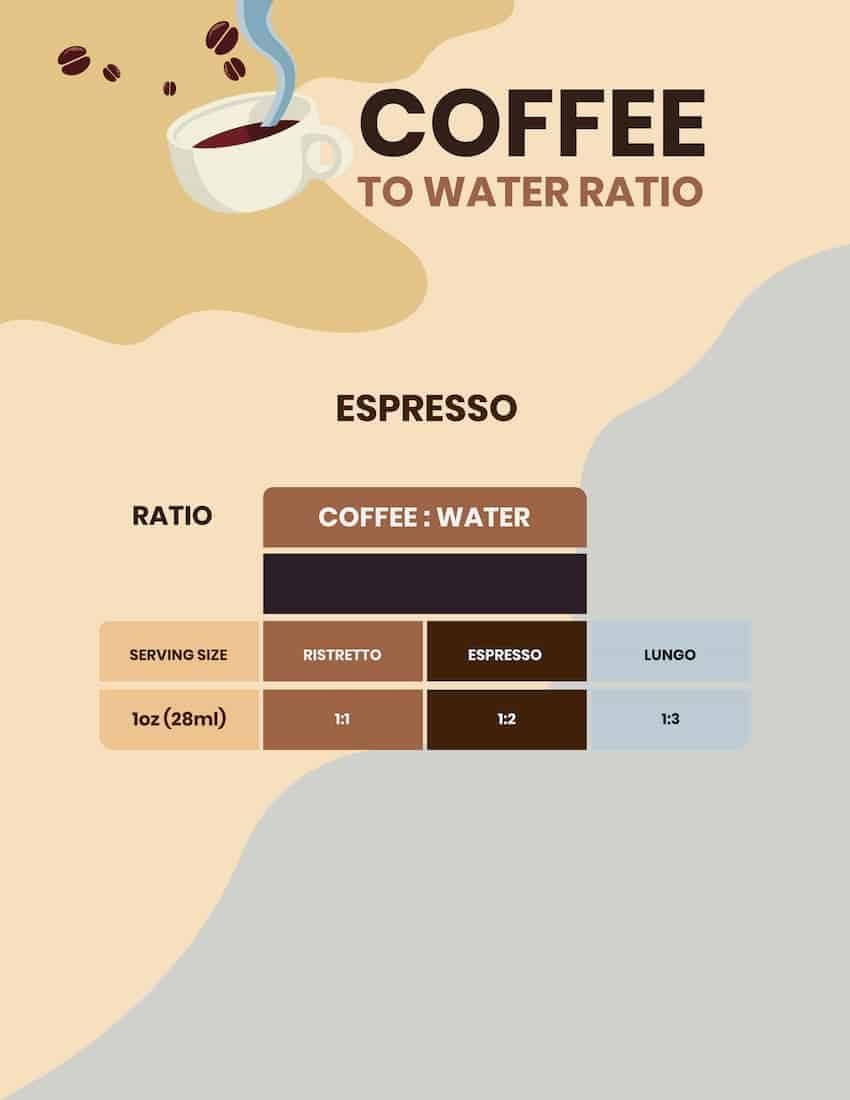
With an espresso machine we get into a whole different ballgame.
When I give espresso workshops, I talk about the ratios in espresso and how those variations actually produce different drinks.
Those drinks have fancy Italian names, but they’re easy to understand. The differences are based on how many grams of coffee are used to pull the shot.
- A ristretto has the least water, with a ratio of 1:1 (ristretto means restricted, as in the amount of water being restricted). It’s for people looking for the most intense espresso.
- At a ratio of 1:2 you have a common espresso. Espresso means pressed in Italian since the water is pressed through the ground beans at high pressure.
- A lungo, at a 1:3 ratio, has less coffee and will create a less intense shot. This Italian word means long, meaning more water passes through the ground beans for a longer time.
The best way to find the perfect ratio for your preferences, the methods you have, and the coffee available to you is to keep notes or create a simple chart. Think of it as a coffee journal.
Each time you make a cup take note of the method, the amount of coffee, the amount of water, brewing times, any changes in pouring technique, and the results. Over time you’ll understand the best balance for you.
Cold Brew Coffee
There’s nothing quite like a full-flavored cold brew. Being brewed cold, cold brews are rather different from your regular coffee cup.
Getting your cold brew coffee just right is pretty easy. A 1:8 ratio is probably the most common, but it can be stretched as far as 1:15.
I go over this in some detail in another post. You can read all about it in my post about cold brew coffee ratios.
The Science Behind Coffee Ratios
As we mentioned, the most important aspect when brewing is how the coffee tastes in the cup. Good coffee is a matter of preference and will be different for every person.
Once you know what you consider to be good, you can move on to the next step to ensure you get consistent results. In fact, with coffee, you can scientifically calculate and measure the results.
Why do we care about the science behind a coffee ratio?
Because the science that goes into your brew methods alters how it tastes in your cup.
Using science, you can examine the results of your efforts and have an idea of how good it will be even before you taste it. What can you examine? There are several factors to look for.
One factor is the amount of coffee solids in the brew. When you talk about getting a strong cup, that strength can actually be measured. Those coffee solids are called total dissolved solids, or TDS.
While it sounds technical, TDS refers to the concentration of solids in the brewed coffee. The TDS tells you how strong the coffee is, and the amount of solids in a coffee varies the body and the clarity.
Between 18-22% TDS is considered ideal.
Why do people in the coffee world care about the solids? This info can help them measure and control extraction, and they use it to brew consistently good coffee.
How do you measure those solids? You just need a refractometer.
A what?
Yes, you probably haven’t heard of refractometers, unless you work in the coffee industry. It’s a hand-held machine that measures the TDS in a cup of coffee or how much coffee is actually in the brew.
Do you need a refractometer to brew good coffee? No. What should really shape your thinking is how the coffee tastes. That’s why not many people invest in a refractometer.
How Brewing Methods Affect The Results
Going further into the science/coffee connection, I’d like to mention brewing methods. Some methods give the brew more body, whereas others provide more clarity.
As you can see in the chart below, a French Press adds a lot of body but little clarity. All the sediment you find in the bottom of the cup when you brew with a French Press is evidence of that.
On the other end of the spectrum, we have pour overs and siphons, which have paper filters that make sure little sediment gets through.
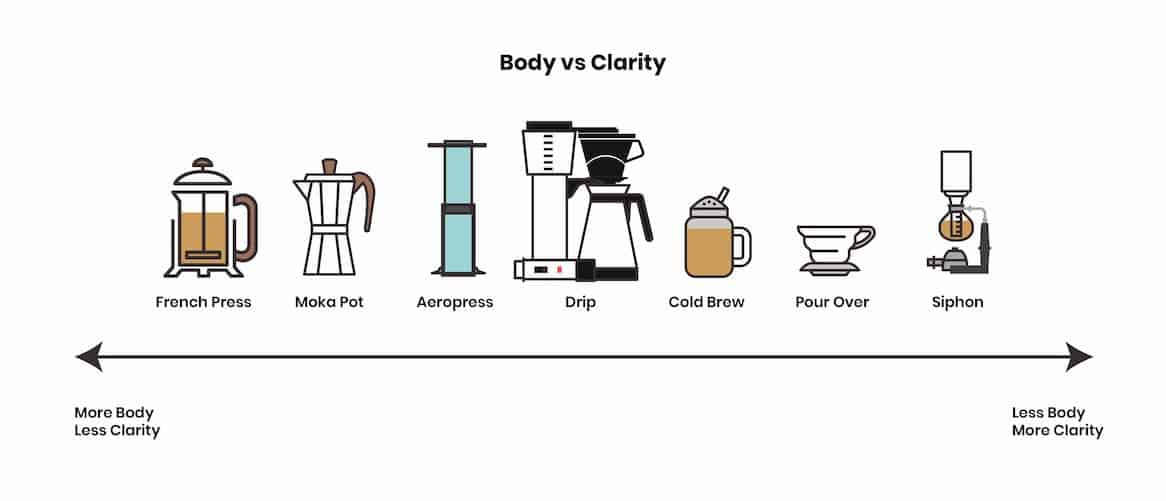
Those coffees have a lot of clarity, and you can taste any complex flavors in the coffee. The other methods, such as Moka Pot, Aeropress, and drip coffee makers, fall somewhere in between.
How methods affect the results is important to know when you’re preparing to brew a coffee. What do you want to get out of a certain coffee?
When I prepare for coffee tastings, I choose the coffee and brew it to emphasize certain characteristics.
While most people are used to coffee that’s strong or has a lot of body, they’re not as familiar with fruity coffees.
Or incredibly complex coffees, where you can find many flavors (or even dozens of flavors) in one cup. I can adjust the acidity just by choosing a different method.
What Affects How Strong The Coffee Is?
To determine – or change – how strong a cup of coffee is, you have to consider four major factors. Brew ratio, grind size, extraction time, and temperature.
Brew ratio – as we’ve discussed, how much ground coffee you use will change how strong it is. The adjustments you make in the amount of coffee, even if it’s by just a gram or two, can also dramatically change the results.
Grind – The size of the grind is vital. The smaller the grind, the more solids will be extracted into your brew. A finer size will extract coffee faster. A grind that’s too coarse for the method you’re using may result in a coffee that doesn’t taste like much at all.
While the size of the grind can affect how strong a particular coffee is, it also affects how bitter it is. So a fine grind is not always going to be positive and could get you a bitter cup.
Extraction time – How long coffee and water stay in contact with each other determines how much solids are extracted and how strong the coffee is.
A longer extraction time may produce a coffee that has more body – but also will extract more bitterness. Over extracted coffee, where water was left in contact with the grounds for longer than desirable, tastes bitter.
Temperature – a higher water temperature extracts coffee at a faster rate. Keeping the range between 195-205 degrees Fahrenheit and 90-96 degrees Celsius ensures a good brew. If you go above that, you’ll essentially burn the coffee, and the coffee tastes bitter. If you go too below that ideal temperature, your coffee won’t extract enough, and you’ll be left with a weak brew.
The Golden Cup Ratio
The Golden Cup Ratio is that perfect balance between water and coffee grounds. Does perfection exist? Not often.
But that desire to reach perfection moved the SCA (Specialty Coffee Association) to decide on the Golden Cup Standard, which includes the ratio.
These ratios aren’t new in the coffee world. Way back in the 1950s, the Coffee Brewing Institute saw the need to give guidance on the best brewing practices.
What’s the goal of the Golden Cup Standard? To balance out the body, acidity, and sweetness in coffee.
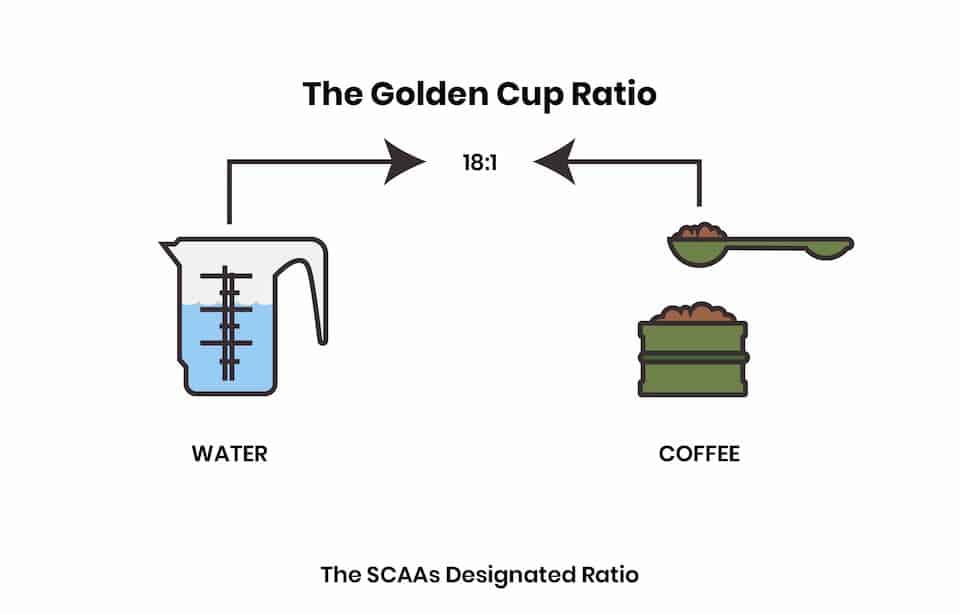
The goal is a perfect balance with outstanding tastes.
What is this desired golden ratio, that special rule we should all start with? It’s 1:18. That is, for each part of coffee grounds, you add 18 parts of water. In practice, that ratio guides you to make a cup (180 ml of water) with 10 grams of ground coffee.
Ratios make it easy to adjust the amounts you make. If we simply gave you the amount to make one 8-ounce cup of coffee, you would get a headache when you need to make three cups or nine cups.
A ratio makes it easy to calculate the weights for whatever number of cups you need.
If you really want to get deep into the science behind the coffee, let’s briefly talk about the official definition of the Golden Ratio to define brew strength.
To measure brew strength, the standard indicates that the TDS should be between 11.5 and 13.5 grams per liter. That’s an extraction yield between 18 and 22 percent of solubles.
But is this Golden Ratio useful?
The Golden Cup Standard Isn’t Faultless
As with all ideals, the Golden Ratio has its flaws. For starters, the ideal ratio depends on what you like. No one, not even leaders in the coffee industry, can tell you what you like to drink.
Also, to determine the results of the Golden Ratio you need to have access to a refractometer.
Most people don’t have one, and there’s a reason for it. The real problem isn’t the price since refractometers have come down in price, and a lot of home brewers could afford one.
The real problem is the usefulness of knowing just how many solids are in your cup.
Even if you know that you have 23% solids in your cup, will that tell you how you should brew it the next time? Maybe not, because in the end the important part is how the coffee tastes.
Also, the golden ratio doesn’t take into account grind size or water temperature, which also plays a role in coffee extraction, as we already mentioned. Higher temperatures extract coffee at a faster rate, which might alter the ratio, brewing time, and strength.
The Golden Cup standard also expects you to understand how to taste coffee the way professionals do, which not everyone does.
Carefully evaluating and scoring coffee based on body, acidity, sweetness, and aftertaste help you understand the results, but not everyone needs to take that time and make that effort to know if their coffee tastes good or not.
Wrapping Up
We went over a lot of coffee science in this article.
We talked about the right ratio and how to figure it out to brew coffee. We went over how to adjust the ratio and how much coffee you use depending on your brew method and desired brew strength. We even talked about total dissolved solids.
You’re probably wondering what you should do with all that information. Practice! Practice makes perfect coffee.
Keep a brewing journal and write down the variations in measurements, time, and techniques. Evaluate what worked according to your personal taste and what needs some improvement.
Enjoy the fantastic results you get in the cup when you understand coffee brewing and science.

